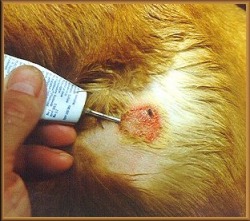• Increase the number of grooming sessions to remove all of the shedding undercoat. Be careful not to scrape or damage the dogs skin by putting too much pressure on the comb or brush.
• Damp coats are another problem causer. If your dog goes swimming, be sure to rinse the dog off with clean water and dry the coat thoroughly with towels or a hair dryer set on cool.
• A natural approach can be very helpful as well. Pet skin care products that contain chamomile, tea tree oil or aloe vera can clear up most hot spots in just a few days. Aloe vera and chamomile are soothing ingredients to help reduce pain and promote healing. There seems to be no single cause for developing these itchy spots, however, the problem can be associated with any of the following things, such as: surface skin infection, "clipper rash", irritants, foreign objects in the coat, as well as trauma and allergies.
The most common areas for hot spots to occur are the rump, legs, feet and flanks - but these infections can also appear other places such as on the back, ears, neck, and chest.
To treat, you need to treat the sore and then remove the underlying cause to prevent recurrences. Suggested methods include trimming the hair around the sore to prevent further spread of the infection. You want to dry the spot out and get air into the infected area.
Next, wash the area with a mild water-based astringent or antiseptic. Personally, I use a simple mixture of water, hydrogen peroxide (3%) and rubbing alcohol to treat my dogs if they ever come down with a hot spot. Here's how I make it: in a regular drinking glass, I fill about 3 tablespoons full of hydrogen peroxide, add 1 teaspoon of rubbing alcohol and then fill it the rest of the way up with water and stir.
It is very important that you do not put in too much alcohol or peroxide. By itself, alcohol can burn intensely. Would you put straight alcohol on a fresh wound on yourself? I didn't think so. And concerning hydrogen peroxide, if applied directly to any wound it can kill tissue which will not allow for correct healing. So, you want a large amount of water and only a small amount of peroxide with just a splash of alcohol.
Cool compresses can be applied several times a day as well. Medications such as oral antibiotics, topical drying sprays, special shampoos, antibiotics or cortisone may be needed as well depending on severity of the hot spots.
In severe cases, your veterinarian may even suggest the use of an Elizabethan collar to prevent further self mutilation and to give the spot a chance to heal completely. If your dog needs veterinary help for any skin lesion, or hot spot, don't delay in making that call.
Cool compresses can be applied several times a day as well. Medications such as oral antibiotics, topical drying sprays, special shampoos, antibiotics or cortisone may be needed as well depending on severity of the hot spots.
In severe cases, your veterinarian may even suggest the use of an Elizabethan collar to prevent further self mutilation and to give the spot a chance to heal completely. If your dog needs veterinary help for any skin lesion, or hot spot, don't delay in making that call.
research engine: www.total-german-shepherd.com
0 Comments
"Hot spots", also called moist dermatitis, acute moist dermatitis, or Summer Sores, is a term used to describe a varied number of skin problems which are very common in the German Shepherd Dog. |

 RSS Feed
RSS Feed